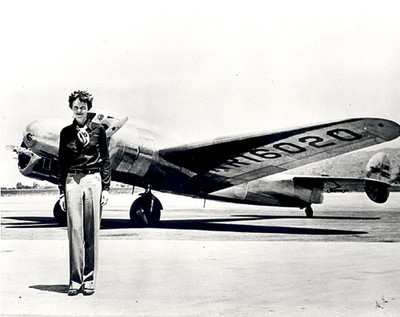Wed, Aug 28, 2024
Drone-Mounted Magnetometers Used To Detect Aircraft Remnants
The Discovery Channel recently released a documentary titled “Finding Amelia”. It showcases an expedition to unearth the fate of legendary aviator Amelia Earhart, which was conducted using drone-mounted magnetometers.

In 1937, Amelia Earhart disappeared over the Pacific Ocean while attempting a round-the-world flight. If she had been successful, she would have become the first person to circumnavigate the globe around the equator. Numerous research teams have organized missions and created theories on the cause of her disappearance, but the remains of her and her aircraft have yet to be discovered.
The "Finding Amelia" documentary features one of the latest, and most successful, efforts. The expedition began in February 2021 with Ric Gillespie and SPH Engineering’s teams.
The journey occurred in the jungles of New Britain in Papua New Guinea. The team arrived on site carrying a load of drones equipped with magnetometer, LiDar, and photogrammetry tech. Before the true search could occur, they used a small drone with a camera to map out the search area. Then, they used LiDAR scans to build Digital Surface Models and Digital Terrain Models. This data was essential in planning out the mission.
The team found that the average vegetation height in the zone was 10-15m. While this permitted the detection of aircraft engines using a magnetometer, outlying treetop heights posed a challenge for magnetic survey planning. They decided to switch back to LiDAR and completed dozens of low-altitude flights. In this, they found what seemed to be hidden Japanese troop trails and an object which bore a resemblance to Earhart’s Lockheed Electra.

“We view the expedition as a success on multiple levels,” explained Alexey Dobrovolskiy, SPH Engineering CEO. “It gave us invaluable experience in extreme conditions and allowed us to test and enhance our technologies. We are truly thankful for the opportunity to contribute to such a historic mission and look forward to being part of similar expeditions in the future.”
“Finding Amelia” aired on August 7 on the Discovery Channel.
More News
Pilot Applied Full Aft Stick And Nose-Up Trim, But The Airplane Remained On The Runway Analysis: The pilot reported that a preflight inspection and flight control checks revealed n>[...]
A Few Questions AND Answers To Help You Get MORE Out of ANN! 1) I forgot my password. How do I find it? 1) Easy... click here and give us your e-mail address--we'll send it to you >[...]
From 2022 (YouTube Edition): Before They’re All Gone... Humankind has been messing about in airplanes for almost 120-years. In that time, thousands of aircraft representing i>[...]
Advanced Air Mobility (AAM) A transportation system that transports people and property by air between two points in the NAS using aircraft with advanced technologies, including el>[...]
Aero Linx: MQ-1B Predator The MQ-1B Predator is an armed, multi-mission, medium-altitude, long-endurance remotely piloted aircraft that is employed primarily as an intelligence-col>[...]
 NTSB Final Report: Douglas A-4K
NTSB Final Report: Douglas A-4K ANN FAQ: Q&A 101
ANN FAQ: Q&A 101 Classic Aero-TV: PBY Catalina--From Wartime to Double Sunrise to the Long Sunset
Classic Aero-TV: PBY Catalina--From Wartime to Double Sunrise to the Long Sunset ANN's Daily Aero-Term (07.01.25): Advanced Air Mobility (AAM)
ANN's Daily Aero-Term (07.01.25): Advanced Air Mobility (AAM) ANN's Daily Aero-Linx (07.01.25)
ANN's Daily Aero-Linx (07.01.25)




